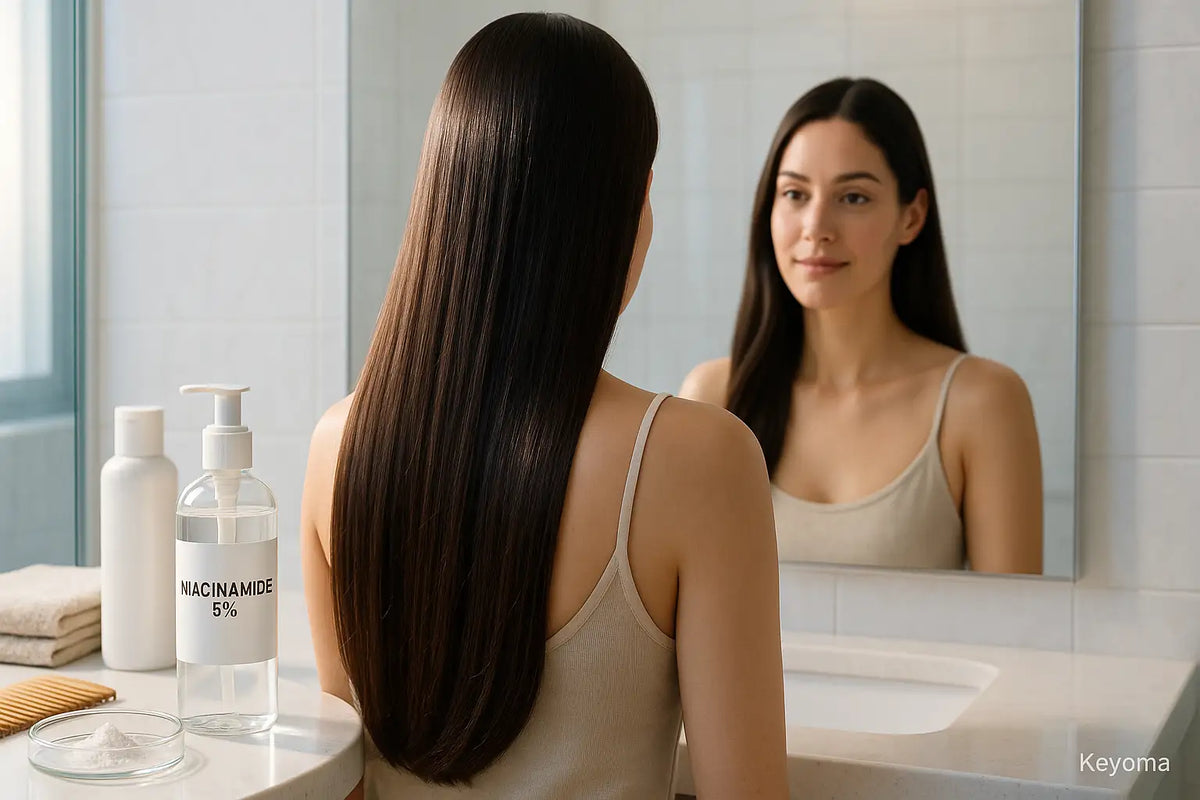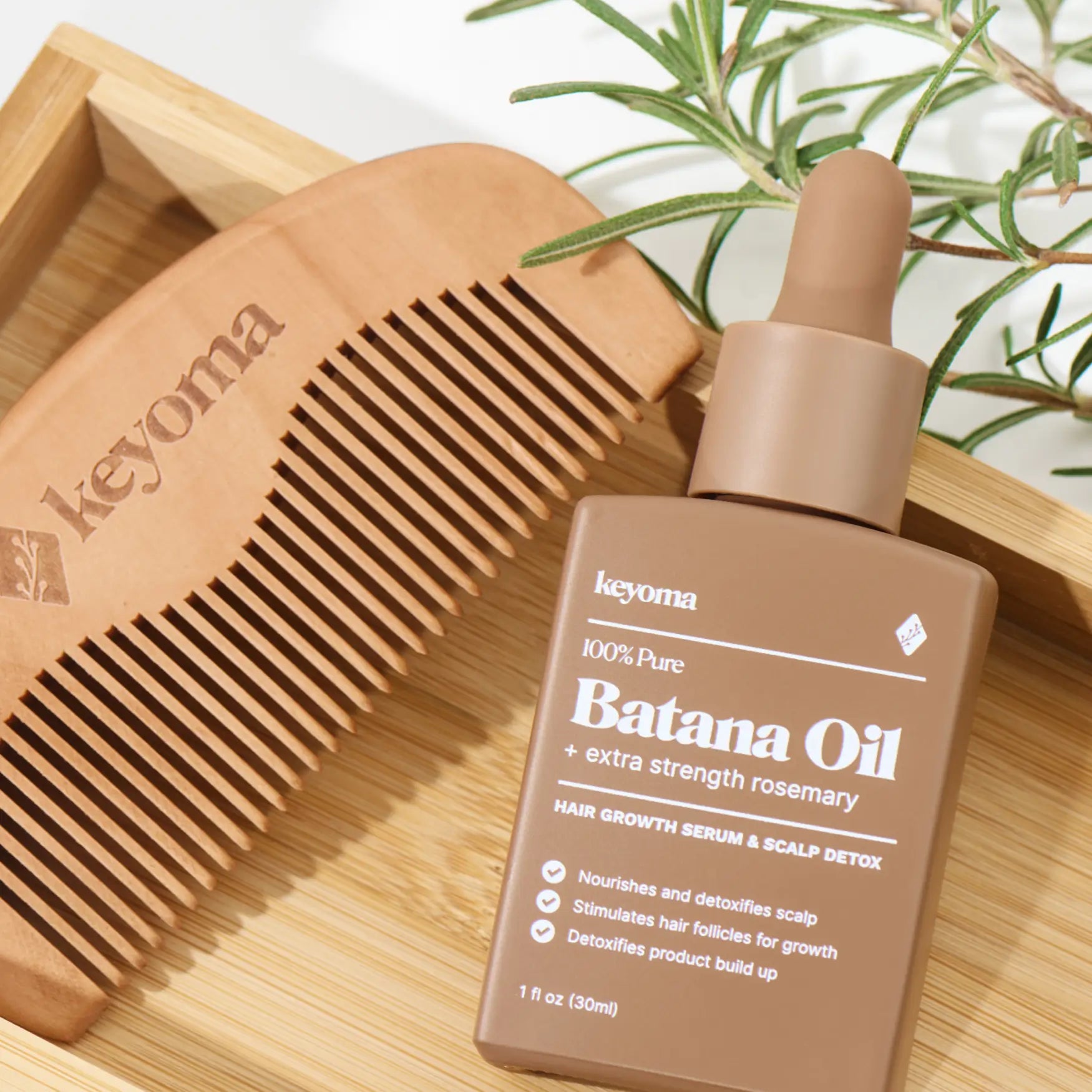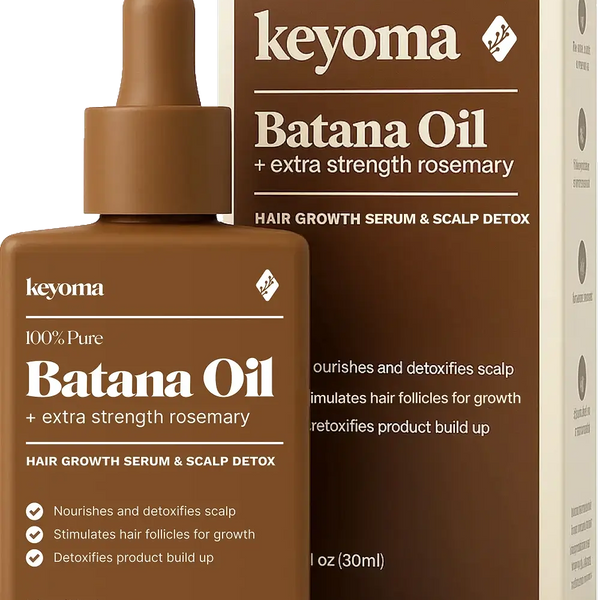In this article
Niacinamide is a form of vitamin B3 that’s big in skin care. It can fit into hair care as well. Below, you’ll see how it may support stronger, well-nourished strands and make your hair feel easier to manage.
Key Takeaways
-
Niacinamide, a form of vitamin B3, can strengthen hair by supporting keratin and moisture retention.
-
It may improve scalp health by reducing inflammation, regulating oil, and protecting against oxidative stress.
-
Shampoos, conditioners, masks, and DIY tonics can deliver benefits with proper dilution and consistency.
-
Side effects are uncommon, but niacinamide intake has limits and topical use warrants patch testing.
What Is Niacinamide?
Niacinamide is a version of vitamin B3 (niacin), an essential nutrient that supports your skin, kidneys, heart, nerves, gut, brain, and other organs in your body.
You get niacin from greens, whole grains, lean meats, soy milk, eggs, yeast, salmon, and many other foods. When niacin runs high, your body converts some of it to niacinamide. Your body can also make niacinamide from the amino acid tryptophan.
Manufactured niacinamide is commonly used to make moisturizers, serums, and other skin-care products.
How Niacinamide Supports Hair Health
Like skin, different hair types bring their own concerns, and certain ingredients can help address them. Because niacinamide (vitamin B3) is water soluble and supports normal cell function, it can help you work toward healthy-looking hair with lasting shine and movement.
Using topical niacinamide in your routine can support protein production (including keratin) and moisture retention, which can encourage hair growth and a fuller-looking mane.
Niacinamide Benefits for Skin and Scalp
Overall, niacinamide helps build proteins in the skin and hold in moisture, which may limit damage.
More studies are needed to pin down the possible benefits in detail.
Improves Skin Elasticity
Researchers observed that niacinamide helps widen the spacing between keratin molecules. Keratin is a protein that helps skin stay firm and healthy.
That change could help improve skin elasticity.
Strengthens the Skin Barrier
Current evidence suggests niacinamide could help support the skin’s ceramide (lipid) barrier. That barrier can help the skin retain moisture.
Helps Reduce Inflammation
In the studies I reviewed, niacinamide can help reduce inflammation, which may ease redness and discoloration. This might help manage inflammatory skin conditions such as:
-
Psoriasis
-
Atopic dermatitis
-
Contact dermatitis
Helps Regulate Oil Production
The papers I saw show that niacinamide may help moderate how much oil the sebaceous glands make. This could be helpful for people with oily skin, though we still need more research.
Aids Skin Cell Repair
Small human trials report that niacinamide may help rebuild healthy skin cells after damage from ultraviolet rays.
Even so, keep protecting your skin outdoors by using sunscreen and covering up when you can.
Evens Skin Tone and Texture
Current evidence suggests niacinamide can be helpful for hyperpigmentation or pigmentation issues. It may also soften the look of fine lines and wrinkles.
Shields Against Oxidative Stress
Niacinamide supports skin cells and helps shield them from sunlight, pollution, and other environmental stressors.
May Help With Acne
Early data points to niacinamide may be helpful for managing acne. More research is needed, and other acne products may suit you better.
Possible Side Effects of Niacinamide
At appropriate doses, niacinamide is generally well tolerated, partly because extra amounts are excreted in urine.
The tolerable upper limit for vitamin B3 is 35 mg per day. At this amount, flushing, redness, itching, and tingling are least likely; those effects are linked to nicotinic acid, not niacinamide.
Reports note mild effects with nicotinamide, like stomach discomfort, nausea and headaches.
It has also been suggested that nicotinamide could raise insulin resistance, a hallmark of type 2 diabetes, but the evidence is inconsistent.
It’s still best to talk with your healthcare provider before using niacinamide or any supplement so they can assess your individual risk.
How to Add Niacinamide to Your Hair Care Routine
Niacinamide can fit into wash day, leave-ins, and targeted scalp care without overhauling everything. Check labels for concentration, patch test if your skin is sensitive, and keep other products steady to notice changes.
For me, tracking one tweak at a time made results easier to notice. Give changes several weeks before you judge them. With that in mind, here’s how to add niacinamide to your hair care routine.
Using Hair Products With Niacinamide
The simplest way to use niacinamide for hair is to add it to your current hair care routine. Choose shampoos, conditioners, and masks that list niacinamide as a key ingredient.
Tips for applying the best niacinamide hair products:
-
Pick a formula matched to your hair type: dry, oily, or color-treated hair benefits from the right product.
-
Follow the maker’s directions: use the suggested amount and frequency to get the intended results.
-
Stick with it: as with most routines, steady use over time brings the best outcome.
DIY Niacinamide Options for Home Use
If you like a DIY route, you can put together simple niacinamide hair treatments at home.
Homemade Niacinamide Treatments:
-
Niacinamide Hair Mask: Blend a few drops of liquid niacinamide with your favorite mask or a carrier oil like jojoba. Apply to scalp and hair, wait 20–30 minutes, then rinse well.
-
Niacinamide Scalp Tonic: Mix a diluted niacinamide solution with water and use it on your scalp after shampooing. Massage gently and leave on for 15 minutes before rinsing.
Important Note: If you use pure niacinamide powder, always dilute it with water or a carrier oil to reduce irritation.
Better Hair Days Start Today with Keyoma
Think of niacinamide as support for scalp and strands, not a cure-all. With consistent use, it can help build proteins like keratin, strengthen the barrier to limit water loss, calm excess oil and inflammation, and buffer environmental stress.
Choose products that match your hair type and follow the label, or dilute DIY mixes and patch test first. For clear routines, ingredient explainers, and research updates you can use, follow Keyoma’s blog and social channels for ongoing hair care tips.
Featured Product
100% Pure Batana Oil + Rosemary









